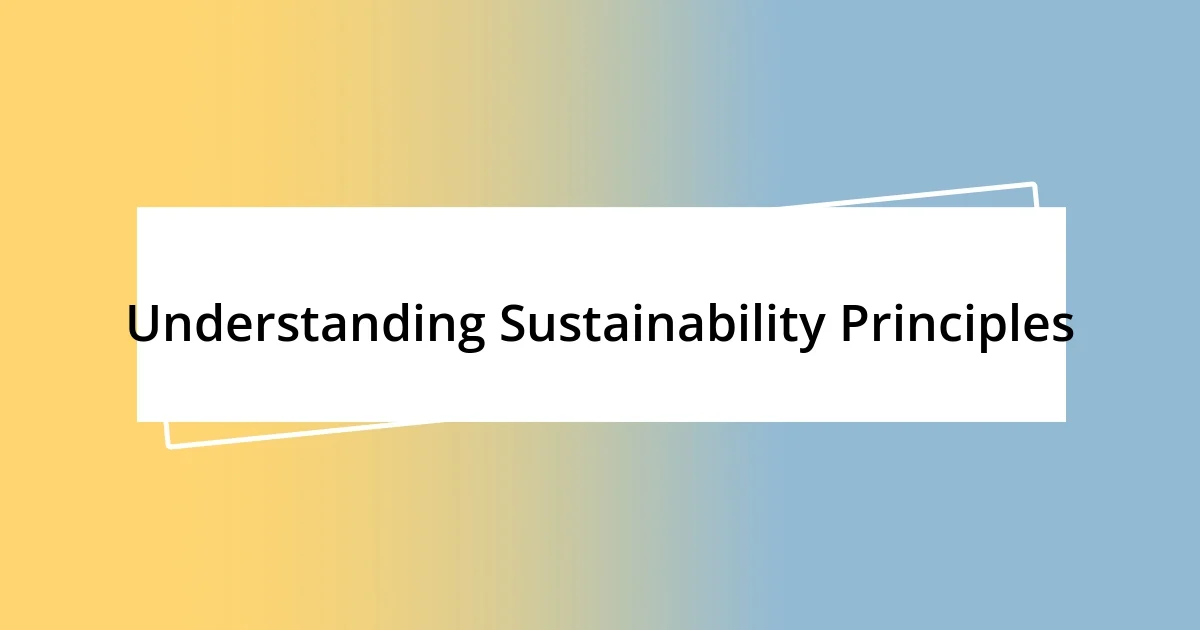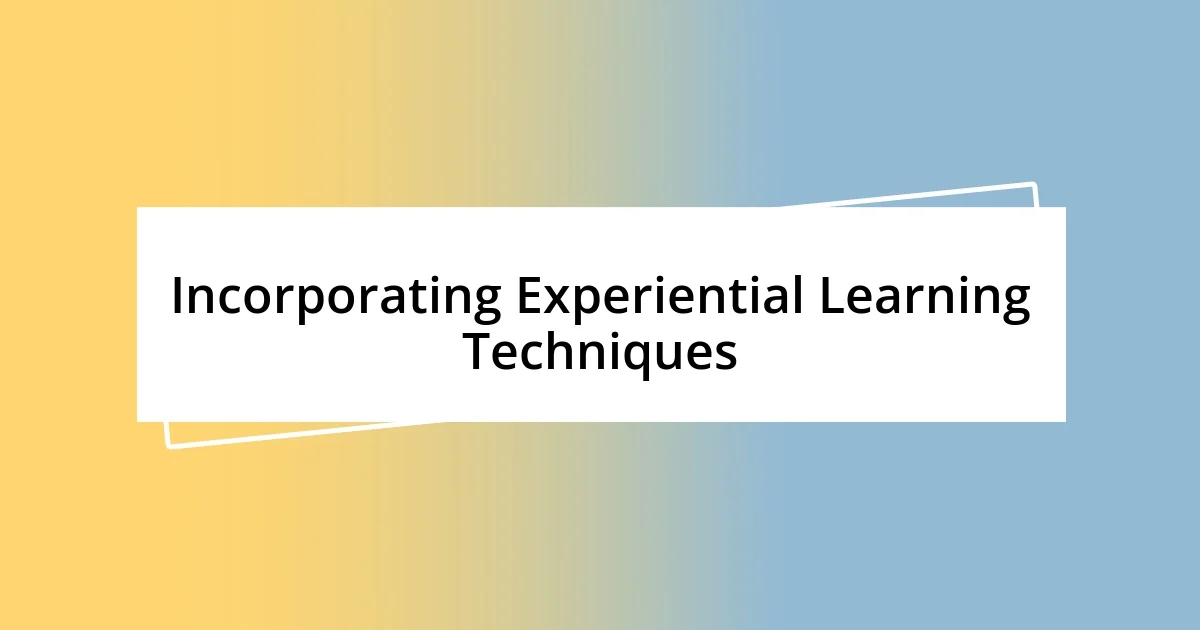Key takeaways:
- Sustainability education emphasizes interconnection, social equity, and the impact of individual actions on future generations.
- Experiential learning techniques, such as hands-on activities and storytelling, effectively engage participants and foster a deeper understanding of sustainability.
- Utilizing technology and community involvement enhances the reach and impact of sustainability initiatives, encouraging collective action and shared learning experiences.

Understanding Sustainability Principles
Sustainability principles revolve around the idea that our actions today should not compromise the ability of future generations to meet their needs. I often think about this when I watch my kids enjoy the outdoors; it strikes me how essential it is to preserve these natural spaces for them and their children. Have you ever considered how your daily habits influence not just your life, but the future of the planet?
One principle I find particularly impactful is the concept of interconnection. Everything is linked, from the air we breathe to the choices we make at the grocery store. I recall a time when I chose to support local farmers by shopping at a nearby co-op, and it felt rewarding to know I was contributing to my community while reducing my carbon footprint. Isn’t it eye-opening to realize that every small action contributes to a larger ecosystem of impacts?
We also focus on the importance of social equity in sustainability. It’s not just about the environment; it’s about ensuring access to resources and opportunities for all. I remember volunteering for a project that aimed to provide community gardens in underserved neighborhoods. Seeing families thrive together made me realize that sustainability isn’t just an environmental issue; it’s also about creating a fair and just society. How can we ignore this vital link between community well-being and environmental health?

Identifying Sustainable Education Methods
To identify effective sustainable education methods, I’ve leaned into experiential learning; it just resonates with people. This hands-on approach fosters deeper connections and understanding. I remember leading a workshop where participants planted trees together; the joy of nurturing those saplings was palpable. It turned a simple lesson about carbon sequestration into a memorable experience. Isn’t it fascinating how active participation can transform information into something tangible?
Here are some methods that can enhance sustainability education:
- Project-Based Learning: Engage learners in real-world sustainability projects, such as community clean-ups or energy audits.
- Interdisciplinary Approaches: Integrate sustainability topics across subjects, making connections to science, economics, and social studies.
- Local Field Trips: Take students to local eco-friendly businesses or farms to see sustainability in action.
- Reflective Practices: Encourage journaling or discussions after activities to deepen understanding and personal connection.
- Use of Multimedia: Incorporate videos, podcasts, and documentaries that showcase successful sustainability initiatives, creating varied learning experiences.
By embracing these methods, I feel we can inspire a generation that not only understands sustainability but is also motivated to take action. It’s about creating a ripple effect—each learner can carry forward their insights and experiences into the world.

Incorporating Experiential Learning Techniques
Incorporating experiential learning techniques has truly reshaped how I educate others on sustainability. One memorable experience that stands out for me was organizing a beach clean-up with a local school. Watching the students transform from hesitant participants to enthusiastic advocates for the environment was absolutely inspiring. Their laughter as they discovered hidden treasures in the sand combined with their newfound awareness made it clear that hands-on activities can ignite passion and commitment. Can you recall a time when being physically involved changed your perspective on an important issue?
Another technique I find effective is simulating real-world environmental challenges. I once led a workshop where attendees were divided into teams to tackle a hypothetical city planning scenario while considering factors like waste management and green spaces. The debates that ensued were intense and engaging. Participants began to see that sustainability is not just theory; it’s something we grapple with in our everyday decisions. Have you ever faced similar challenges in your own community?
Finally, I believe in the power of storytelling as a crucial element in experiential learning. During a recent seminar, I shared my journey of transitioning to a zero-waste lifestyle, complete with the struggles and triumphs along the way. This personal narrative not only resonated with my audience but also encouraged them to share their experiences, creating a rich learning environment. Isn’t it remarkable how stories can bridge gaps and inspire action towards a sustainable future?
| Experiential Learning Technique | Description |
|---|---|
| Hands-on Activities | Engaging participants through activities like tree planting or beach clean-ups fosters direct connections to sustainability. |
| Simulations | Creating scenarios that mimic real-world environmental challenges encourages critical thinking and problem-solving. |
| Storytelling | Sharing personal narratives about sustainability challenges can inspire and connect individuals on a deeper level. |

Utilizing Technology for Education
Utilizing technology in education has opened incredible avenues for spreading the message of sustainability. I’ve found that online platforms, like webinars and virtual workshops, can reach a diverse audience, breaking geographic barriers. Just the other day, I hosted a session on renewable energy for participants across three continents. The shared passion in that digital room felt electric, underscoring how technology can amplify our voices and foster a global dialogue.
In my experience, educational apps and interactive software can transform traditional learning into engaging experiences. I once used a simulation game that lets players manage a city’s resources sustainably. Watching my students navigate their choices reminded me of how much fun learning can be when it’s gamified. Isn’t it astonishing how a simple app can spark critical thinking while also instilling a sense of responsibility?
Additionally, I’ve started to incorporate social media into my teachings, leveraging platforms like Instagram to highlight sustainability initiatives. When I share short, impactful videos about composting, I notice my followers engage by sharing their own tips and tricks. It’s like creating a virtual community dedicated to sustainability; these interactions motivate me to keep pushing the message forward. Have you ever experienced the power of collective learning in this way? In many ways, technology isn’t just a tool; it’s an enabler of change and connection.

Engaging Communities in Sustainability
Engaging communities in sustainability requires a multifaceted approach that resonates with individuals on personal levels. I remember organizing a local community garden project, where every participant brought their unique knowledge and experience to the table. Watching neighbors collaborate, sharing gardening tips and cultural recipes, created a sense of ownership and pride that elevated their commitment to sustainability. Have you ever felt a similar sense of belonging while working alongside others for a common cause?
One of the most transformative experiences I’ve had was when I invited community members to participate in a sustainability day focused on action-oriented workshops. We crafted DIY products, like beeswax wraps and natural cleaners, and the energy was electrifying. Seeing the satisfaction on their faces as they created something tangible was a powerful reminder that sustainability can start at home. It begs the question: how many everyday decisions can we shift if we feel empowered to make those choices ourselves?
Moreover, storytelling can be an incredibly potent tool for fostering community engagement. I once shared my experience of a year-long challenge to reduce single-use plastics at a local event. The candid conversations that followed allowed others to share their struggles and triumphs, creating a supportive network. It’s incredible to reflect on how opening up about my journey sparked discussions that led to collective initiatives, like our neighborhood’s monthly zero-waste challenge. Don’t you think that when we share our vulnerabilities, we create pathways for others to connect and inspire change?

Evaluating the Impact of Education
Evaluating the Impact of Education
Reflecting on the effectiveness of educational initiatives in sustainability often brings me back to specific moments. I remember a time when I conducted a feedback session after a workshop focused on water conservation. The insights participants shared about changing their daily habits helped me realize that understanding leads to tangible action. Who knew that simple discussions could ignite such profound changes in behavior?
Understanding the outcomes of educational efforts is crucial to refine our approaches. For example, I once surveyed attendees from several of my sustainability workshops, asking them how they applied what they learned at home. The excitement in their responses revealed not just personal growth but also a ripple effect—family members and friends began to adopt more sustainable practices thanks to them. Isn’t it fascinating how one person’s engagement can spark a larger conversation within their social circles?
To truly evaluate impact, I often suggest incorporating metrics that track behavior changes over time. Personally, I initiated a follow-up program to check in with past participants six months after their workshops. The enthusiasm they expressed in sharing updates reinforced my belief—education is more than just facts; it’s about creating shared experiences that empower. Have you ever felt motivated to take action simply because someone believed in your potential? That’s the kind of impact I strive to achieve through my educational efforts.














